Entry Database : PDB / ID : 7d8rTitle MITF HLHLZ structure Microphthalmia-associated transcription factor,Methionyl-tRNA synthetase beta subunit Keywords / Function / homology Function Domain/homology Component
/ / / / / / / / / / / / / / / / / / / / / / / / / / / / / / / / / / / / / / / / / / / / / / / / / / / / / / / / / / / / / / / / / / / / / / / / / / / / / / / / / / / / / / / / Biological species Homo sapiens (human)Aquifex aeolicus VF5 (bacteria)Method / / / Resolution : 3 Å Authors Guo, M. / Fang, P. / Wang, J. Funding support Organization Grant number Country National Natural Science Foundation of China (NSFC) 21778064 National Natural Science Foundation of China (NSFC) 21778067 National Natural Science Foundation of China (NSFC) 21977108 National Natural Science Foundation of China (NSFC) 21977107
Journal : Cell Res. / Year : 2023Title : A unique hyperdynamic dimer interface permits small molecule perturbation of the melanoma oncoprotein MITF for melanoma therapy.Authors: Liu, Z. / Chen, K. / Dai, J. / Xu, P. / Sun, W. / Liu, W. / Zhao, Z. / Bennett, S.P. / Li, P. / Ma, T. / Lin, Y. / Kawakami, A. / Yu, J. / Wang, F. / Wang, C. / Li, M. / Chase, P. / Hodder, ... Authors : Liu, Z. / Chen, K. / Dai, J. / Xu, P. / Sun, W. / Liu, W. / Zhao, Z. / Bennett, S.P. / Li, P. / Ma, T. / Lin, Y. / Kawakami, A. / Yu, J. / Wang, F. / Wang, C. / Li, M. / Chase, P. / Hodder, P. / Spicer, T.P. / Scampavia, L. / Cao, C. / Pan, L. / Dong, J. / Chen, Y. / Yu, B. / Guo, M. / Fang, P. / Fisher, D.E. / Wang, J. History Deposition Oct 9, 2020 Deposition site / Processing site Revision 1.0 Oct 13, 2021 Provider / Type Revision 2.0 Feb 16, 2022 Group Advisory / Atomic model ... Advisory / Atomic model / Data collection / Derived calculations / Non-polymer description / Refinement description / Structure summary Category atom_site / atom_site_anisotrop ... atom_site / atom_site_anisotrop / chem_comp / entity / pdbx_contact_author / pdbx_entity_nonpoly / pdbx_nonpoly_scheme / pdbx_refine_tls / pdbx_refine_tls_group / pdbx_struct_assembly_gen / pdbx_struct_assembly_prop / pdbx_struct_sheet_hbond / pdbx_unobs_or_zero_occ_atoms / pdbx_validate_torsion / refine / refine_hist / refine_ls_shell / reflns / reflns_shell / software / struct_asym / struct_conf / struct_sheet / struct_sheet_order / struct_sheet_range Item _chem_comp.formula / _chem_comp.formula_weight ... _chem_comp.formula / _chem_comp.formula_weight / _chem_comp.id / _chem_comp.mon_nstd_flag / _chem_comp.name / _chem_comp.type / _pdbx_refine_tls.L[1][1] / _pdbx_refine_tls.L[1][2] / _pdbx_refine_tls.L[1][3] / _pdbx_refine_tls.L[2][2] / _pdbx_refine_tls.L[2][3] / _pdbx_refine_tls.L[3][3] / _pdbx_refine_tls.S[1][1] / _pdbx_refine_tls.S[1][2] / _pdbx_refine_tls.S[1][3] / _pdbx_refine_tls.S[2][1] / _pdbx_refine_tls.S[2][2] / _pdbx_refine_tls.S[2][3] / _pdbx_refine_tls.S[3][1] / _pdbx_refine_tls.S[3][2] / _pdbx_refine_tls.S[3][3] / _pdbx_refine_tls.T[1][1] / _pdbx_refine_tls.T[1][2] / _pdbx_refine_tls.T[1][3] / _pdbx_refine_tls.T[2][2] / _pdbx_refine_tls.T[2][3] / _pdbx_refine_tls.T[3][3] / _pdbx_refine_tls.origin_x / _pdbx_refine_tls.origin_y / _pdbx_refine_tls.origin_z / _pdbx_struct_assembly_gen.asym_id_list / _pdbx_struct_assembly_prop.value / _pdbx_struct_sheet_hbond.range_1_auth_asym_id / _pdbx_struct_sheet_hbond.range_1_auth_atom_id / _pdbx_struct_sheet_hbond.range_1_auth_comp_id / _pdbx_struct_sheet_hbond.range_1_auth_seq_id / _pdbx_struct_sheet_hbond.range_1_label_asym_id / _pdbx_struct_sheet_hbond.range_1_label_atom_id / _pdbx_struct_sheet_hbond.range_1_label_comp_id / _pdbx_struct_sheet_hbond.range_1_label_seq_id / _pdbx_struct_sheet_hbond.range_2_auth_asym_id / _pdbx_struct_sheet_hbond.range_2_auth_atom_id / _pdbx_struct_sheet_hbond.range_2_auth_comp_id / _pdbx_struct_sheet_hbond.range_2_auth_seq_id / _pdbx_struct_sheet_hbond.range_2_label_asym_id / _pdbx_struct_sheet_hbond.range_2_label_atom_id / _pdbx_struct_sheet_hbond.range_2_label_comp_id / _pdbx_struct_sheet_hbond.range_2_label_seq_id / _pdbx_struct_sheet_hbond.range_id_1 / _pdbx_struct_sheet_hbond.range_id_2 / _pdbx_struct_sheet_hbond.sheet_id / _refine.B_iso_max / _refine.B_iso_mean / _refine.B_iso_min / _refine.ls_R_factor_R_free / _refine.ls_R_factor_R_work / _refine.ls_R_factor_obs / _refine.ls_d_res_low / _refine.ls_number_reflns_R_free / _refine.ls_number_reflns_R_work / _refine.ls_number_reflns_obs / _refine.ls_percent_reflns_R_free / _refine.ls_percent_reflns_obs / _refine.overall_SU_ML / _refine.pdbx_overall_phase_error / _refine.pdbx_stereochemistry_target_values / _refine.solvent_model_details / _refine_hist.d_res_low / _refine_hist.number_atoms_solvent / _refine_hist.number_atoms_total / _refine_hist.pdbx_B_iso_mean_solvent / _refine_hist.pdbx_number_atoms_protein / _reflns.B_iso_Wilson_estimate / _reflns.d_resolution_low / _reflns.number_all / _reflns.number_obs / _reflns.pdbx_Rmerge_I_obs / _reflns.pdbx_Rpim_I_all / _reflns.pdbx_Rrim_I_all / _reflns.pdbx_Rsym_value / _reflns.pdbx_netI_over_av_sigmaI / _reflns.pdbx_number_measured_all / _software.version / _struct_sheet_order.range_id_1 / _struct_sheet_order.range_id_2 / _struct_sheet_order.sheet_id Description / Details / Provider / Type Revision 2.1 Sep 27, 2023 Group / Database referencesCategory chem_comp_atom / chem_comp_bond ... chem_comp_atom / chem_comp_bond / citation / citation_author Item _citation.country / _citation.journal_abbrev ... _citation.country / _citation.journal_abbrev / _citation.journal_id_CSD / _citation.journal_id_ISSN / _citation.journal_volume / _citation.page_first / _citation.page_last / _citation.pdbx_database_id_DOI / _citation.pdbx_database_id_PubMed / _citation.title / _citation.year
Show all Show less
 Open data
Open data Basic information
Basic information Components
Components Keywords
Keywords Function and homology information
Function and homology information Homo sapiens (human)
Homo sapiens (human)
 Aquifex aeolicus VF5 (bacteria)
Aquifex aeolicus VF5 (bacteria) X-RAY DIFFRACTION /
X-RAY DIFFRACTION /  SYNCHROTRON /
SYNCHROTRON /  SAD / Resolution: 3 Å
SAD / Resolution: 3 Å  Authors
Authors China, 4items
China, 4items  Citation
Citation Journal: Cell Res. / Year: 2023
Journal: Cell Res. / Year: 2023 Structure visualization
Structure visualization Molmil
Molmil Jmol/JSmol
Jmol/JSmol Downloads & links
Downloads & links Download
Download 7d8r.cif.gz
7d8r.cif.gz PDBx/mmCIF format
PDBx/mmCIF format pdb7d8r.ent.gz
pdb7d8r.ent.gz PDB format
PDB format 7d8r.json.gz
7d8r.json.gz PDBx/mmJSON format
PDBx/mmJSON format Other downloads
Other downloads 7d8r_validation.pdf.gz
7d8r_validation.pdf.gz wwPDB validaton report
wwPDB validaton report 7d8r_full_validation.pdf.gz
7d8r_full_validation.pdf.gz 7d8r_validation.xml.gz
7d8r_validation.xml.gz 7d8r_validation.cif.gz
7d8r_validation.cif.gz https://data.pdbj.org/pub/pdb/validation_reports/d8/7d8r
https://data.pdbj.org/pub/pdb/validation_reports/d8/7d8r ftp://data.pdbj.org/pub/pdb/validation_reports/d8/7d8r
ftp://data.pdbj.org/pub/pdb/validation_reports/d8/7d8r Links
Links Assembly
Assembly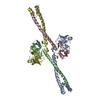
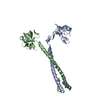

 Components
Components Homo sapiens (human), (gene. exp.)
Homo sapiens (human), (gene. exp.) 
 Aquifex aeolicus VF5 (bacteria)
Aquifex aeolicus VF5 (bacteria)
 X-RAY DIFFRACTION / Number of used crystals: 1
X-RAY DIFFRACTION / Number of used crystals: 1  Sample preparation
Sample preparation SYNCHROTRON / Site:
SYNCHROTRON / Site:  APS
APS  / Beamline: 21-ID-F / Wavelength: 0.97857 Å
/ Beamline: 21-ID-F / Wavelength: 0.97857 Å Processing
Processing SAD / Resolution: 3→38.693 Å / SU ML: 0.63 / Cross valid method: THROUGHOUT / σ(F): 2.1 / Phase error: 44.02 / Stereochemistry target values: ML
SAD / Resolution: 3→38.693 Å / SU ML: 0.63 / Cross valid method: THROUGHOUT / σ(F): 2.1 / Phase error: 44.02 / Stereochemistry target values: ML Movie
Movie Controller
Controller



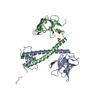
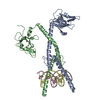
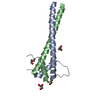

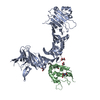


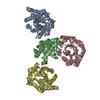
 PDBj
PDBj









